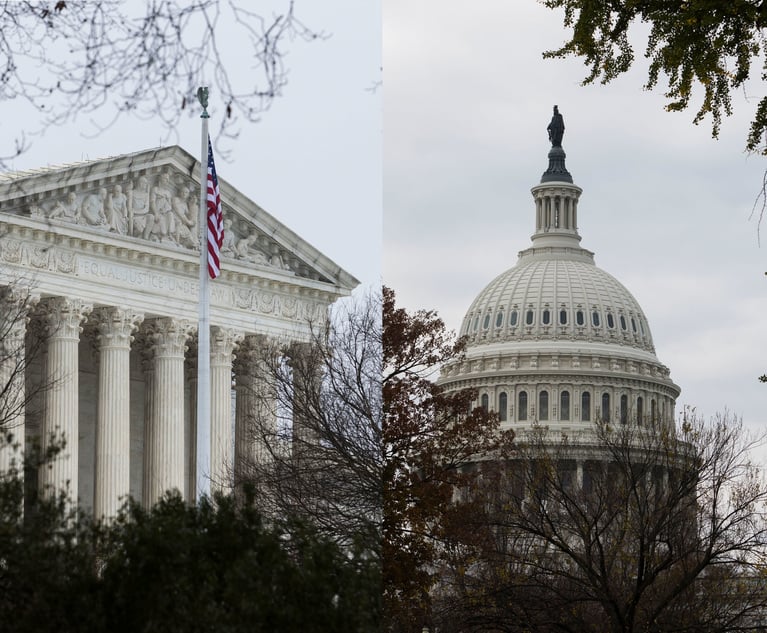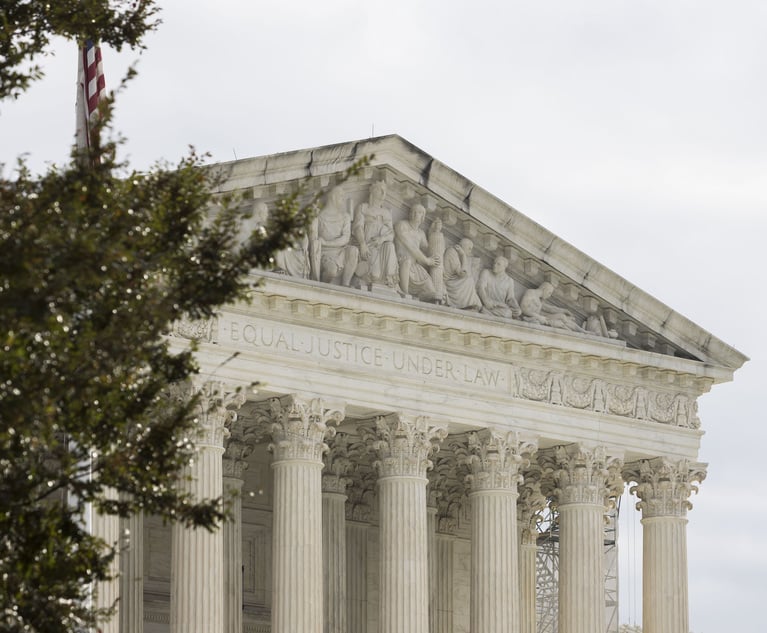Updated SCOTUS Website Gets Mixed Reviews
The Supreme Court's re-launched site is more mobile-friendly but leaves serious court watchers itching for digital updates that are more than cosmetic.
July 31, 2017 at 03:30 PM
3 minute read
The U.S. Supreme Court's much-anticipated website update launched late on July 28, making information about the court easier for the public to find on mobile devices as well as computers.
But, befitting an institution whose building is decorated with bronze and marble tortoises, the changes were baby steps. In announcing the improvements, the court said they pave the way, eventually, for a planned electronic filing system that will make Supreme Court briefs and documents available to all on the site.
In his annual report in late 2014, Chief Justice John Roberts Jr. said the electronic filing system “may be operational as soon as 2016” but that too has turned out to be a work in progress.
The new website has been panned and praised, with one Twitter critic opining, “#SCOTUS website looks somewhat different but not sure how much better … (doesn't really look much better).”
Brianne Gorod, chief counsel of the Constitutional Accountability Center, who tweeted last week that she was “very excited” to see the changes, said Monday, “It's great to see some updates to the court's website, but what I'll be really excited about is when we see the new electronic filing system.”
At least one social media complaint about the site has already been corrected.
Over the weekend, most pages on the site showed text in blue against a scarlet background that made it difficult to read. “My eyes are bleeding, this is the worst thing ever,” proclaimed one viewer. Another called it a “bloodbath travesty.” But by Monday morning, the site reverted to black type on a white background.
Over the weekend, the site's main page also mistakenly announced that cases set for argument in October had actually already taken place.
Some of the most helpful changes give the lay public more information about what is happening at the court on any given day, including case names and information about cases being argued. The site also gives quick information about visiting the court, including “etiquette” guidance such as “touching of portraits, bust, or other artifacts on exhibit is strictly prohibited.”
Gabe Roth, executive director of the advocacy group Fix the Court, said that in addition to the new website, the court needs to do much more to improve transparency. “The court said its website improvements would support 'future digitization,' but if that phrase appeared in a law, it would be struck down for being unconstitutionally vague,” Roth said Monday. “Does this future, in their view, include hosting live broadcast of oral arguments and opinion announcements, online financial disclosures and a justice-by-justice conflicts list? It should.”
This content has been archived. It is available through our partners, LexisNexis® and Bloomberg Law.
To view this content, please continue to their sites.
Not a Lexis Subscriber?
Subscribe Now
Not a Bloomberg Law Subscriber?
Subscribe Now
NOT FOR REPRINT
© 2025 ALM Global, LLC, All Rights Reserved. Request academic re-use from www.copyright.com. All other uses, submit a request to [email protected]. For more information visit Asset & Logo Licensing.
You Might Like
View All
Roberts Calls Court's Relationship With Congress 'Strained.' Who's to Blame?

Judicial Conference Declines Democratic Request to Refer Justice Thomas to DOJ

Chief Justice Roberts Ends Year With Defense Against 'Illegitimate' Attacks on Judiciary

Trending Stories
- 1Restoring Trust in the Courts Starts in New York
- 2'Pull Back the Curtain': Ex-NFL Players Seek Discovery in Lawsuit Over League's Disability Plan
- 3Tensions Run High at Final Hearing Before Manhattan Congestion Pricing Takes Effect
- 4Improper Removal to Fed. Court Leads to $100K Bill for Blue Cross Blue Shield
- 5Michael Halpern, Beloved Key West Attorney, Dies at 72
Who Got The Work
Michael G. Bongiorno, Andrew Scott Dulberg and Elizabeth E. Driscoll from Wilmer Cutler Pickering Hale and Dorr have stepped in to represent Symbotic Inc., an A.I.-enabled technology platform that focuses on increasing supply chain efficiency, and other defendants in a pending shareholder derivative lawsuit. The case, filed Oct. 2 in Massachusetts District Court by the Brown Law Firm on behalf of Stephen Austen, accuses certain officers and directors of misleading investors in regard to Symbotic's potential for margin growth by failing to disclose that the company was not equipped to timely deploy its systems or manage expenses through project delays. The case, assigned to U.S. District Judge Nathaniel M. Gorton, is 1:24-cv-12522, Austen v. Cohen et al.
Who Got The Work
Edmund Polubinski and Marie Killmond of Davis Polk & Wardwell have entered appearances for data platform software development company MongoDB and other defendants in a pending shareholder derivative lawsuit. The action, filed Oct. 7 in New York Southern District Court by the Brown Law Firm, accuses the company's directors and/or officers of falsely expressing confidence in the company’s restructuring of its sales incentive plan and downplaying the severity of decreases in its upfront commitments. The case is 1:24-cv-07594, Roy v. Ittycheria et al.
Who Got The Work
Amy O. Bruchs and Kurt F. Ellison of Michael Best & Friedrich have entered appearances for Epic Systems Corp. in a pending employment discrimination lawsuit. The suit was filed Sept. 7 in Wisconsin Western District Court by Levine Eisberner LLC and Siri & Glimstad on behalf of a project manager who claims that he was wrongfully terminated after applying for a religious exemption to the defendant's COVID-19 vaccine mandate. The case, assigned to U.S. Magistrate Judge Anita Marie Boor, is 3:24-cv-00630, Secker, Nathan v. Epic Systems Corporation.
Who Got The Work
David X. Sullivan, Thomas J. Finn and Gregory A. Hall from McCarter & English have entered appearances for Sunrun Installation Services in a pending civil rights lawsuit. The complaint was filed Sept. 4 in Connecticut District Court by attorney Robert M. Berke on behalf of former employee George Edward Steins, who was arrested and charged with employing an unregistered home improvement salesperson. The complaint alleges that had Sunrun informed the Connecticut Department of Consumer Protection that the plaintiff's employment had ended in 2017 and that he no longer held Sunrun's home improvement contractor license, he would not have been hit with charges, which were dismissed in May 2024. The case, assigned to U.S. District Judge Jeffrey A. Meyer, is 3:24-cv-01423, Steins v. Sunrun, Inc. et al.
Who Got The Work
Greenberg Traurig shareholder Joshua L. Raskin has entered an appearance for boohoo.com UK Ltd. in a pending patent infringement lawsuit. The suit, filed Sept. 3 in Texas Eastern District Court by Rozier Hardt McDonough on behalf of Alto Dynamics, asserts five patents related to an online shopping platform. The case, assigned to U.S. District Judge Rodney Gilstrap, is 2:24-cv-00719, Alto Dynamics, LLC v. boohoo.com UK Limited.
Featured Firms
Law Offices of Gary Martin Hays & Associates, P.C.
(470) 294-1674
Law Offices of Mark E. Salomone
(857) 444-6468
Smith & Hassler
(713) 739-1250










